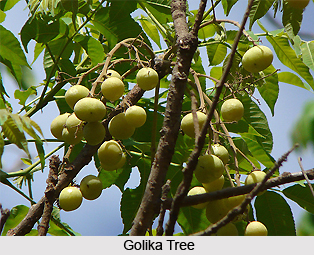 Golika serves as an essential herb under the Indian medicinal plant spectrum and has Garuga pinnata as its scientific name. However, Golika is also famous in other native dialects like: dabdabe, nil bhadi, turn karphat in Bengali; kakad and khusimb in Gujarati; ghogar, kaikar, kenkar, kharpat, kharput, turn in Hindi; aranelli, bilagadde, doddadumpli, hallubolige, nelligadde in Kannada; halabal-age, kadad, kusimba in Konkani; karu-vempu, kareyam, kattukalinjan in Malayalam; kakad, karuk, kudak in Marathi; handulomohi, kikodu, mohi, sompotri in Oriya; karnikara, kinkirata, krsnamilka, paranki in Sanskrit; karrevemba and karuvembu in Tamil; and gargu, garuga, kondavepa in Telugu.
Golika serves as an essential herb under the Indian medicinal plant spectrum and has Garuga pinnata as its scientific name. However, Golika is also famous in other native dialects like: dabdabe, nil bhadi, turn karphat in Bengali; kakad and khusimb in Gujarati; ghogar, kaikar, kenkar, kharpat, kharput, turn in Hindi; aranelli, bilagadde, doddadumpli, hallubolige, nelligadde in Kannada; halabal-age, kadad, kusimba in Konkani; karu-vempu, kareyam, kattukalinjan in Malayalam; kakad, karuk, kudak in Marathi; handulomohi, kikodu, mohi, sompotri in Oriya; karnikara, kinkirata, krsnamilka, paranki in Sanskrit; karrevemba and karuvembu in Tamil; and gargu, garuga, kondavepa in Telugu.
Golika can be seen to bloom throughout India up to an elevation of approximately 900 metres and most commonly grows in mixed deciduous forests. This specific Indian medicinal plant matures to a medium height, essentially growing as a deciduous tree. The bark of the plant appears thick, soft, greyish or brown from the outside and red within, that peels off in irregular flakes. Golika`s leaves are imparipinnate and are placed at alternate intervals, with lengths varying from 15 to 45 centimetres. They are clustered at the ends of branches with leaflets bunched in 5 to10 pairs, including a terminal one. The leaflets are positioned at opposite measurements, varying from 5 to 15 centimetres in length and 2 to 5 centimetres in breadth.
The leaves of Golika are much compound in shape, bearing further specifications like lanceolate or ovate-lanceolate in shape, with the apex usually going acuminate and the base oblique. Its margins differentiate from appearing crenated to serrated and is pubescent when young. This Indian medicinal plant`s flowers are small and bell-shaped in size, bearing a yellow colour. Golika`s flowers bloom in much-branched terminal clusters, together at the ends of branches. Its bracts also bear the quality of being deciduous with its calyx being 6 millimetre in length, further enhanced by being campanulate and downy tomentose from outside. The bracts of Golika possess lobes which are ovate to oblong and even subobtuse. The flower petals measure 5 millimetre in length, with shapes differing from being linear to oblong and tomentous from outside. Golika`s flower petals are attached to the tube of the calyx beneath the margin of the disc. The fruit of this Indian medicinal plant is globose in shape, appearing fleshy and smooth. Golika`s fruit is known to be edible, bearing characteristics of being a black drupe, approximately 1.8 centimeter in length. The pyrenes of the black drupe measures within 1 to 3 centimetres and is also bony. The seed of this deciduous Indian medicinal plant is encased within a membranous wing.
During the rainy season and the cool months of October and November, the leaves of Golika often turn orange or crimson in colour before shedding. This Indian medicinal plant bears flower within February and April and fruits from May to July. The trees remain leafless between December to January and June, essentially in central Indian deciduous forests.
Golika assimilates within itself various medicinal properties and finds usage for chronic ailments. The fruit of the Indian medicinal plant is credited with stomachal properties. The astringent juice of the leaves, mixed with that of Justicia adhatoda (Acanthaceae) and Vitex negundo (Verbenaceae) and honey, is employed to treat asthma in the Konkan region. The boiled bark from Golika, done into a paste, is applied externally to promote healing of bone fractures among the Sahariyas of north-western Madhya Pradesh. The juice from the stem is also known to have been in regular usage used as an eye-drop to cure opacities of the conjunctiva.



















